Textiles and Dress Designing - Fabric Decorations | 11th Textiles and Dress Designing : Chapter 14 : Garments Decoration and Trimming
Chapter: 11th Textiles and Dress Designing : Chapter 14 : Garments Decoration and Trimming
Fabric Decorations
Fabric Decorations
Fabric decorations are items made out of textile materials and attached to the garment. They are stitched at the edges or specific areas of the garments to enhance its look.
Some of the common fabric decora-tions are discussed below:
Ric Rac
It is a zig zag narrow trimming used for adornment. It is available in different colour and it is cost efficient. It can be used as a motif or can be sewn flat on a garment. They are made of different material like cotton, nylon and polyester (Figure 14.1).
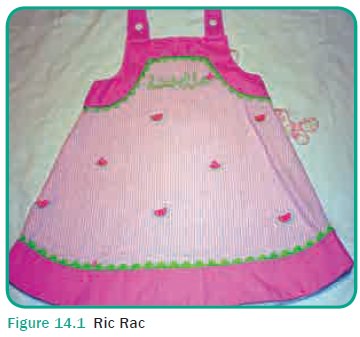
Ruffles and Frills
Ruffles are a piece of fabric pleated or gathered at one edge to release fullness. It can be used for decoration as well as for finishing raw edges. Ruffles can beautify a plain garment and can also emphasize a section of a garment.
Frills can be added along the hem of a garment or inserted in seam or any section. The fineness of the fabric and the amount of drape are always related to create frills. If cut in circular fabric, frills, flares at hemline and smooth where it is attached. It can be used around the neck-line, collar and sleeve. It gives flowing movement to a garment. They are used in lingerie, children garment and nightwear (Figure 14.2).
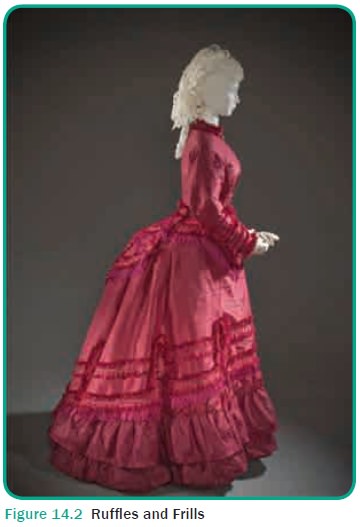
Scallops
Scallops are one of the easiest ways to decorate a garment. They should be spaced evenly. These are mostly done on straight edge. They form rhythmi-cal edging on a plain garment. Scallops can be done on necklines and edges of a garment to add beauty to a garment. (Figure 14.3).
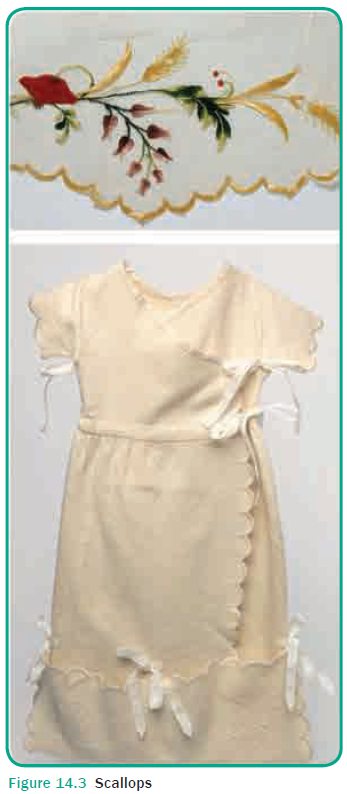
Patch Work
A piece of fabric with or without embel-lishment is attached on garment for dec-orative purposes are called as patches. These can be done by hand or machine. For hand patch work, loop stitch can be used. In machine patch work running or satin stitches are used. Normally soft and lustrous fabrics are used for patch work. This gives a rich look.
Patch work is used in clothes, table cover, sofa cover and in children garments. Patch used should be of same weight of fab-ric on to which it is done. If the patch used is heavy the garment will lose it shapes. They can be used to mend hole. Closely woven fabric cannot be used for patch as it will be difficult to sew (Figure 14.4).

Appliqué
Appliqué is the method of attaching a con-trasting material on a large back ground. Appliqué can be trimmed after stitching. Appliqué may vary in pattern, colour and texture. It can be done by hand or machine. Now-a-days sew on or stitch on appliqués are readily available.
In beach wear, simple and bold designs are used. The material used for appliqué can be leather, felt fabric, lace and net. Many other techniques such as quilting, beading and machine embroi-dery can be combined to create variety (Figure 14.5).

Quilting
Quilting is technique of giving a textured look to the garment. It adds weight and warmth. Generally geometrically designs like circles, diamond shapes and square are done in quilting. Quilting is done on running fabric before cutting the patterns.
Foam is placed in between the gar-ment fabric and the lining fabric. Lines are stitched to create the required effect. Later patterns are placed on this fabric and cut and used for the garment making. Quilting can be done for specific areas like yokes. Contrast colour threads or embroidery threads can be used in the bobbin to cre-ate interest in quilting work (Figure 14.6).

Belts
Belt is an important fashion accessory. It can be used as a design feature or it can act as a main focal point in a design. It can give the whole design a delicate effect.
The different types of fasten-ers used with belts are hooks, buckles, claps, ties, studs. We can create variety by using different materials, fasteners, leather or a combination of above mate-rial (Figure 14.7).
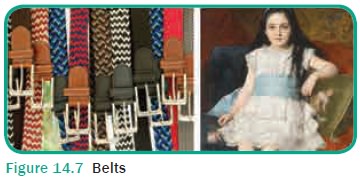
Bows
Bows are used as fasteners or it can also be used as decorative feature in a garment. Bows made from taffeta, cotton, linen pro-duce a sharp and crisp look. Soft bows can be made from soft fabric that drapes well. A bow can be stitched at neckline, waist line or it can be tied at the back to give an interesting effect. When bows are cut in bias, they drape well (Figure 14.8).

Smocking
Smocking is a trim in which embroidery is done over a gathered edge for both func-tional and decorative purpose. It is used in children garment, yokes, sleeves, waist-line and neckline of a garment. We can create variety in smocking. Smocking can be done on light weight fabric. Smocking gives textured effect (Figure 14.9).
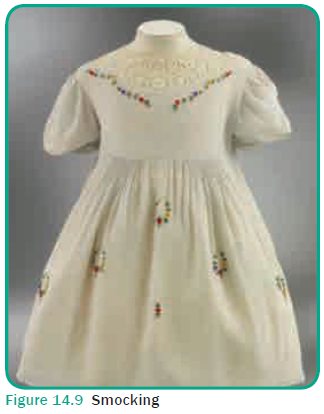
Laces
Laces can be used at edge, to increase length or to decorate a garment. Decorative lace can be made by hand, machine, cro-chet needle and tatting. Laces made from crochet needle can be attached on the edge of the garments. Decorative laces are used in frocks, hoods, saris, shawls and skirts. They are available in many colours, size and shape. These are readily available in markets (Figure 14.10).
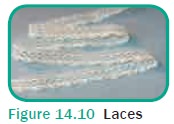

Related Topics